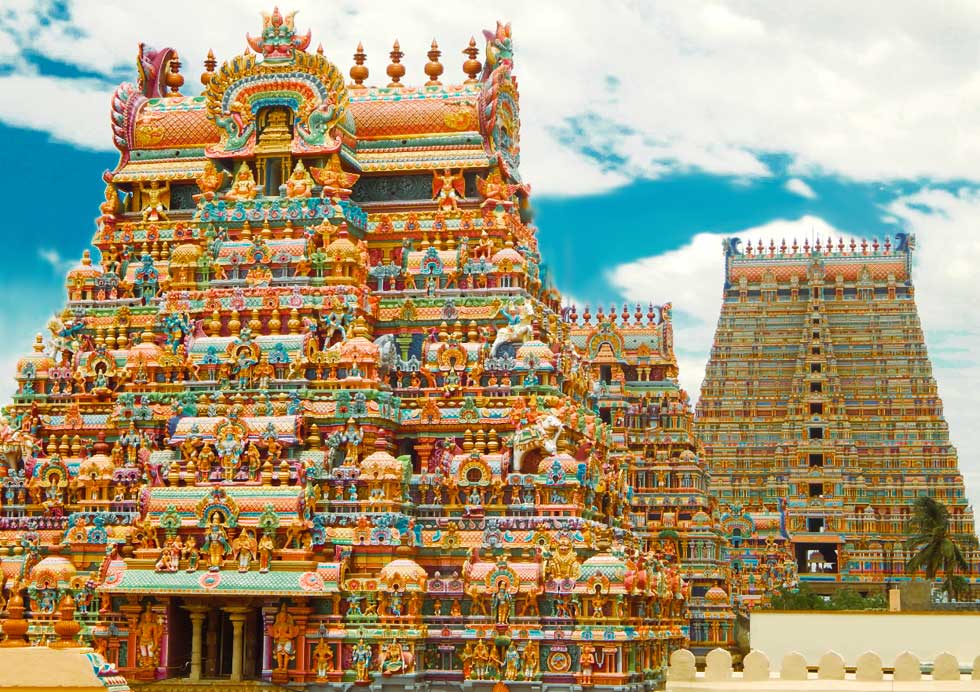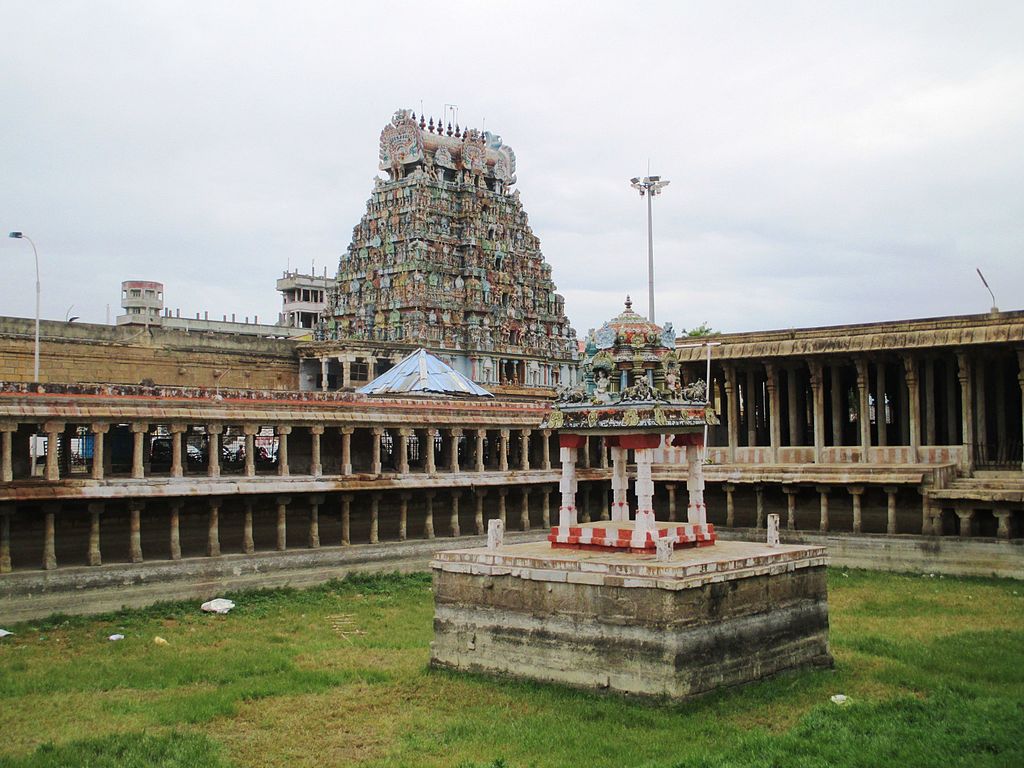Sri Ranganatha Swamy Temple, Srirangam

Introduction
The Sri Ranganatha Swamy Temple, located in Srirangam, Tamil Nadu, is the largest functioning Hindu temple in the world and one of the most sacred Vaishnavite shrines dedicated to Lord Vishnu. The temple is affectionately called “Bhooloka Vaikuntam” (the earthly abode of Lord Vishnu) and is renowned for its spiritual significance, architectural splendor, and vibrant festivals.
The temple is the foremost of the 108 Divya Desams (holy abodes of Lord Vishnu) and is unique as it enshrines Lord Vishnu in a reclining posture, known as Ranganatha. The deity rests on Adisesha, the serpent with five heads.
History
Mythological Significance:
According to legend, the Sri Ranganatha idol was originally worshipped by Lord Brahma in Satyaloka. The idol was later given to King Ikshvaku of the Solar Dynasty. Over time, it was handed down to Lord Rama, who gifted it to Vibhishana, the brother of Ravana, as a token of gratitude for his support in the Ramayana.
While Vibhishana was carrying the idol to Lanka, it was placed temporarily in Srirangam. The idol miraculously became immovable, and it was decided that Lord Vishnu wished to remain there, making Srirangam his eternal abode.
Construction:
The temple dates back to at least the Sangam period (3rd century BCE to 3rd century CE).
The structure as seen today was developed and expanded over centuries by the Chola, Pandya, Hoysala, Vijayanagara, and later Nayak kings.
Historical Events:
During the Delhi Sultanate invasion in the 14th century, the idol was moved to Tirupati for safekeeping. After peace was restored, the idol was reinstalled at Srirangam.
Saint Ramanujacharya, a revered Vaishnavite philosopher, played a pivotal role in the spiritual and administrative organization of the temple.
Temple Architecture
The Sri Ranganatha Swamy Temple is a masterpiece of Dravidian architecture, spread over 156 acres, making it the largest temple complex in India.
Prakarams (Enclosures):
The temple has seven concentric prakarams (enclosures), symbolizing the seven layers of the universe.
These enclosures house various shrines, halls, tanks, and gardens.

Gopurams (Temple Towers):
The Rajagopuram (main tower) is the tallest temple tower in Asia, standing at 236 feet and constructed during the Vijayanagara period.
Other gopurams are intricately carved with mythological depictions.
Garbhagriha (Sanctum):
The sanctum houses the majestic idol of Lord Ranganatha, reclining on Adisesha. The idol is decorated elaborately during special occasions.
Mandapas (Halls):
The temple has several beautiful mandapas, including the Thousand Pillar Mandapam, known for its exquisite sculptures.
Sacred Tank:
The Chandrapushkarani tank is located within the temple for rituals and purification.

Significant Pilgrim Spots in the Temple
Garbhagriha:
The reclining idol of Lord Ranganatha is the main attraction, radiating divine grace and tranquility.
Thousand Pillar Mandapam:
An architectural wonder with intricately carved pillars depicting mythological stories.
Golden Vimana:
The sanctum’s roof is adorned with a gold-plated vimana.
Shrines:
The temple houses numerous shrines for Lord Vishnu’s consorts, Goddess Ranganayaki (Lakshmi), and other deities like Narasimha and Rama.

Festivals
Vaikunta Ekadasi:
The most prominent festival celebrated in December-January, attracting lakhs of devotees. The Paramapada Vasal (Heavenly Gate) is opened on this day, symbolizing the pathway to salvation.
Panguni Uthiram:
A significant event in March-April commemorating the celestial wedding of Lord Ranganatha and Goddess Ranganayaki.
Brahmotsavam:
Held multiple times a year, featuring grand processions of the deity on various vahanas (divine mounts).
Aadi Pooram:
Celebrates Goddess Andal’s devotion to Lord Ranganatha.
Why This Generation Should Visit?
Spiritual Enlightenment:
Visiting the temple provides an opportunity to experience divine grace, serenity, and inner peace.
Architectural Marvel:
Witnessing the temple’s grandeur is a journey through ancient Indian art and architecture.
Cultural Legacy:
The temple is a treasure trove of Tamil heritage, mythology, and spirituality.
Historical Importance:
Exploring the temple connects one to centuries of Indian history and devotion.
Nearby Attractions
Thiruvanaikaval Temple:
Dedicated to Lord Shiva, this temple is located nearby and represents the water element in the Panchabhoota temples.

Rockfort Temple:
A famous hilltop temple in Trichy offering panoramic views.
Samayapuram Mariamman Temple:
A popular temple dedicated to Goddess Mariamman.
Uyyakondan Thirumalai Temple:
A serene spot with beautiful carvings and inscriptions.
How to Reach
By Air:
Nearest Airport: Tiruchirappalli International Airport (15 km away).
By Train:
Nearest Station: Srirangam Railway Station, well-connected to major cities.
By Road:
Srirangam is accessible by buses and taxis from Trichy and other nearby cities.
Contact Details
Address:
Sri Ranganatha Swamy Temple,
Srirangam, Trichy, Tamil Nadu – 620006, India.
Phone: +91-431-2432246 (Temple Office).
Email: info@srirangamtemple.org (if available).
Website: www.srirangam.org
Dear Hindu relatives…
Like this, there are wonderful historical explanations along with Photos of 50+ South Indian Temple .
If you take any Subscription Plan… you will receive the premium version of Bhaaratha Vahini.
This premium version grants you unlimited access to all contents in this App, including our “BHAARATHA VAHINI” Monthly Magazine (E-Paper).


